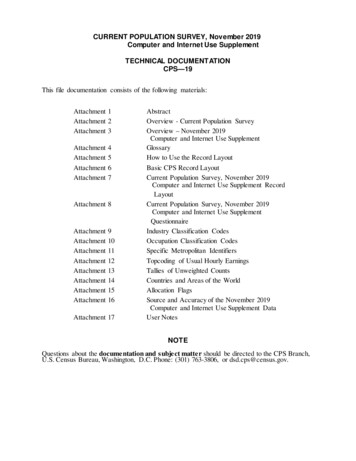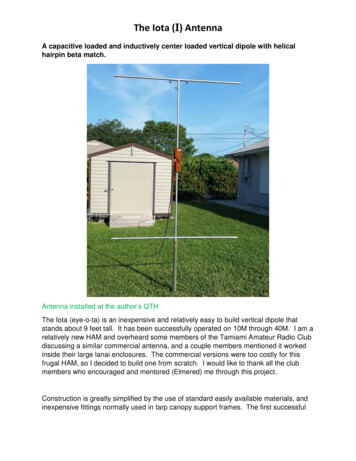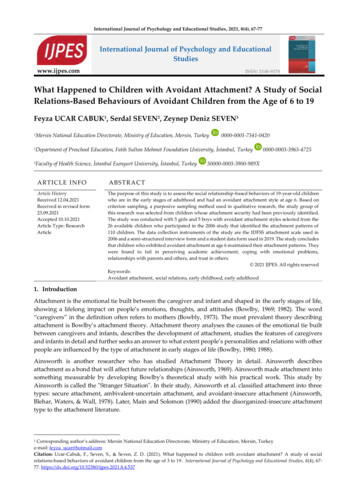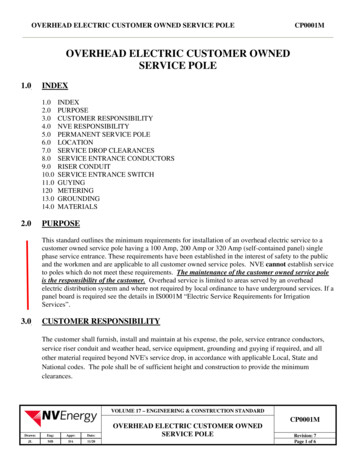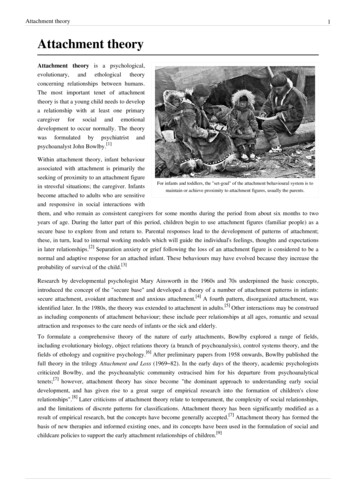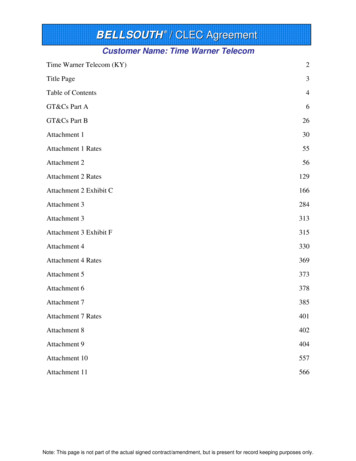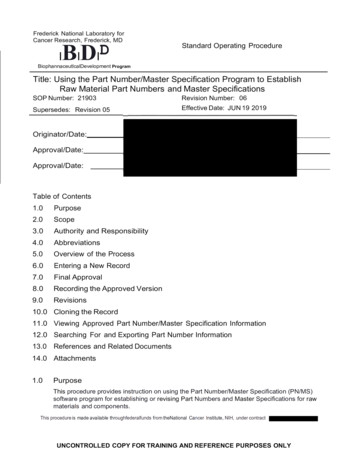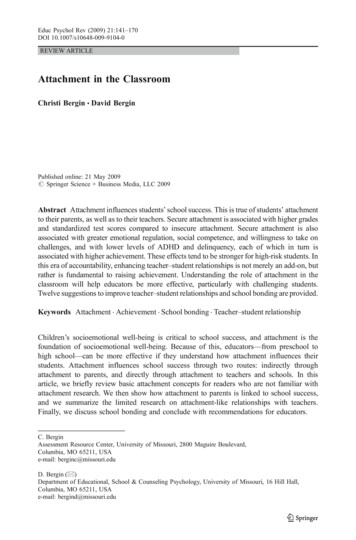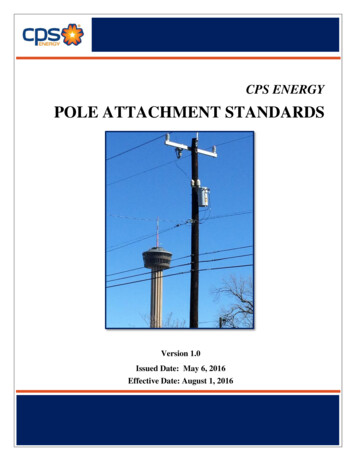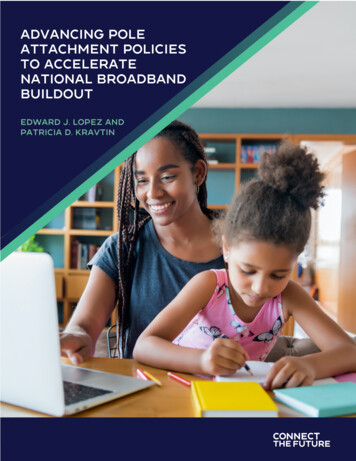
Transcription
ADVANCING POLEATTACHMENT POLICIESTO ACCELERATENATIONAL BROADBANDBUILDOUTEDWARD J. LOPEZ ANDPATRICIA D. KRAVTIN1
ABOUT THE AUTHORSEdward Lopez ejlopez@wcu.eduProfessor of Economics, BB&T DistinguishedProfessor of Capitalism, and Director of the Centerfor the Study of Free Enterprise at Western CarolinaUniversity. He has taught university economics forover two decades and has authored over 60scholarly publications and two books. He holds aPh.D. in economics from George Mason University,where his fields of concentration were publiceconomics and industrial organization.Patricia Kravtin pdkravtin@comcast.netOwner and Principal of Patricia D. Kravtin EconomicConsulting, a private consultancy specializing intelecommunications, energy, cable regulation andbroadband markets. She is frequently called upon as anexpert witness on pole attachment related mattersbefore state, federal, and international regulatory bodies.Ms. Kravtin studied in the Ph.D. program in economicsat MIT, with concentrations in Government Regulationof Industry, Industrial Organization, and Urban andRegional Economics.This report has been underwritten by Connect The Future. Theopinions and viewpoints expressed are those of the authors alone.2
EXECUTIVE SUMMARYBetween 14 to 42 million Americans currently 491 million and 1.86 billion.lack access to high-speed broadband. In thisstudy, we estimate that expanding broadbandUtility poles represent a critical input inaccess to this unserved population wouldbroadband deployment, as attachment tocreate anywhere from 83 billion to 314existing pole networks is the most efficientbillion of new economic gains to America’smeans to expand high-speed broadbandhomes and small businesses. This estimatedaccess to currently unserved areas of thegain represents the social return on newcountry. Policymakers should initiatepublic and private sector investments, namelymeasures now to recapture this economicthe productive, commercial, educational,value by revising and modifying state andhealth, and other benefits that stand to befederal pole policies to mitigate pole ownerrealized by achieving full broadbandmarket power in order to facilitate broadbandexpansion in America.deployment.Today, broadband deployment is beinginhibited or outright stopped due to the lackof effective pole policy to address problematicbehavior of certain utility pole ownersaffecting broadband provider access to utilitypoles. Specifically, pole owners frequentlydeny or delay broadband providers poleattachment access, or impose economicallyunfeasible rates, terms, and conditions thatimpose excessive costs on broadbandproviders associated with pole replacementand upkeep. In economics this is known asPole OwnerHold UpCosts Americans 491M – 1.86Bevery monthit delays expansion.the hold up problem1, an inefficientconcentration of market power that harmsthe public interest.When pole owners hold up the process, theresult is foregone economic gains toAmericans. In this study, we estimate thatevery month of delayed expansion due to poleowner hold up costs Americans between3
INTRODUCTION AND OVERVIEWToo many American homes and smallproductive, commercial, educational, health,businesses still lack access to reliable,civic, and other social benefits that could behigh-speed, low-latency internet connections.realized by achieving full broadbandWhile recent private and public investmentsexpansion.at the national, state, and local levels areplaying a significant role in helping to bridgeTo achieve these economic and social gainsAmerica’s digital divide, policies to removerequires cost efficient and timely attachmentremaining barriers to infrastructureof broadband wires to existing utility poledeployment are now needed to maximize thenetworks. Deployment of broadbandsocial return on public and private broadbandnetworks into unserved rural areas of theinvestments. In this paper, we demonstratecountry requires attachment of broadbandthat the economic gains to full broadbandinfrastructure to thousands and thousands ofexpansion are quite substantial, yet state andpoles. Placement of broadband infrastructurefederal policies governing pole attachmentunderground isn't feasible or cost efficient inprocesses require modification before themost unserved areas of the country.2digital divide can be fully bridged and thoseeconomic gains realized. (See below AppendixExisting pole policies across the country,A, Elements of a Model Pole Policy, for detailshowever, allow electric utility pole owners –of these required modifications.)i.e., investor-owned electric utilities (“IOUs”), aswell as municipal and cooperatively ownedAccording to the Federal Communicationsutilities (“Muni and Coop”) – to exerciseCommission (FCC), more than 14 millionsignificant market power over poleAmericans still lack access to reliable, high-attachment rates, terms, and conditions. Polespeed, low-latency broadband, includingowners frequently impose onerous timetables,nearly 20% of rural households (FCC 2021). Anunfeasible permitting fees, and various pre-estimate by BroadbandNow suggests thatand post-construction requirements, includingover 42 million Americans still lack access. Infull pole replacements ahead of scheduledthis paper, we estimate that connecting thesereplacement, as part of “make-ready”currently unserved populations would createprocedures required prior to the actualas much as 314 billion of new economicattachment to the pole. Pole ownersgains to America’s homes and smallsometimes limit the number of pole-businesses, calculated as additionalattachment applications considered at anywillingness-to-pay (WTP) in net present valuegiven time, and certain pole owners haveover 25 years, or the lower end of averagerefused to consider any applications at all.utility pole life, at 5% discount rate. ThisFurthermore, increasing numbers of Muni andestimated economic gain represents theCoop owners have themselves becomepotential return on private and publicmarket participants in providing broadbandbroadband investments, namely theservice (Beard et al. 2021).344
In the study of economics, this form of marketeconomic gain of full broadband expansionpower is known as the hold up problem, andfor all 50 States, while also including a moreit causes delayed or foregone expansion ofgranular analysis for five focus states (Florida,broadband to currently unserved populations.Kentucky, Missouri, Texas, and Wisconsin).This inefficient and inequitable advantage, inthe absence of effective pole policies, enablesThe analysis in this paper concludes that if thecertain pole owners to impose economicallyeconomic gains from broadband deploymentunfeasible rates, terms, and conditions thatare to be fully realized, policymakers need toharm the public interest by holding upfacilitate the streamlining of equitable accessbroadband deployment. We estimate thatand cost-sharing arrangements betweenevery month of delayed expansion due to polebroadband attachers and pole owners. Theseowner market power costs Americansimproved arrangements, among others, wouldbetween 491 million and 1.86 billion infactor the age and net book value of replacedforegone economic gain, known in economicspoles, thus eliminating a common barrier inas deadweight loss (DWL). The economicwhich broadband providers are too oftenmethodology for this study was initiallyinequitably (and contrary to sound economicdeveloped in an earlier paper that focused onpolicy) required by pole owners to bear theNorth Carolina. That study calculatedfull monetary burden of pole replacementseconomic gains that would be realized withahead of scheduled replacement. These andfull broadband expansion in North Carolinaother key elements of a model pole policyunder just one federal program, the Ruralthat best promote broadband expansion areDevelopment Opportunity Fund (RDOF),presented in Appendix A.56which launched in February, 2020, with a total 20 billion of rural broadband investmentThis barrier to full broadband expansion arisesacross the country.because in most instances the only practical7and economically feasible means for aThe need for a nationwide examination is nowbroadband provider to connect its service to aall the more relevant given the recent passagehousehold or small business location is toof the Infrastructure Investment and Jobs Actattach its wires to the existing network ofof 2021 (“IIJA”) and its massive 42 billionutility poles. Building underground iscommitment to broadband buildout across allunrealistic given the prohibitively higher costs50 states. When combined with federal andas compared to aerial installations along withstate funding already in the pipeline as part ofthe host of other practical, environmental, andthe recent COVID-19 relief packages, thetopographical barriers associated withgovernment funding commitment to deployunderground construction. And the notionbroadband in all 50 states is unprecedented.that broadband providers could build theirTherefore, in this study we enhance andown standalone pole networks would not onlyexpand the analysis beyond North Carolinabe a waste of social resources andand the funding being supplied by RDOF.aesthetically undesirable, in many if not mostResults in this paper include estimates ofinstances would be effectively prohibited5
under zoning rules, environmental regulationsand other laws and ordinances.CRITICAL BACKGROUND AND METHODOLOGYIn this paper, we expand and enhance ourestimates in our calculations of aggregateearlier analysis for North Carolina. First, weeconomic gains.8expand our calculations beyond RDOF and toall 50 states. Nationally, RDOF auctionOur underlying computation methodologyparticipants were awarded over 9 billion tobegins with a representative household’sconnect 5.22 million locations, orestimated WTP for broadband, as provided byapproximately 2 million people. Yet, RDOF isthe Liu, Yu-Hsin, Jeffrey Price and Scotta relatively small program compared to theWallsten (2018). Expressed in layman’s terms,FCC’s estimated 14 million householdsWTP is the highest price that a representativecurrently unserved by broadband, andhousehold would pay to improve from a slowespecially small relative to BroadbandNow’smobile connection to a fixed connection atestimate of over 42 million unserved, and inhigher speeds. WTP therefore represents athe context of the IIJA’s 42 billiondollarized measure of the value to thatcommitment to broadband infrastructure.representative household of broadband’sTherefore, in this paper we also report theproductive, commercial, social, educational,estimated consumer gains if all FCC andentertainment, health, civic and otherBroadbandNow unserved populationsbenefits, to that household. For example, thebecome connected.representative household is willing to pay910 111.08 per month to improve from a MobileSecond, our North Carolina study focused only4/1 Mbps connection at 60-150 Ms latency, toon the benefits of improved bandwidtha Fixed 1000/100 Mbps connection at lessspeeds, whereas in this paper we also accountthan 10 Ms.11for latency improvements being rolled outunder current deployments. Bandwidth speedNext, we aggregate from the household to themeasures the megabits/gigabits of data that asocietal level by multiplying that monthlyconnection can transmit per second (Mbps).WTP by the number of locations becomingLatency measures the milliseconds (Ms) itconnected. In the case of RDOF, for example,takes for a connection to transport a dataif all 5.22 million locations become connected,packet between a user’s computer and otherthat would yield an aggregate 579 millionservers elsewhere on the network. Greaterper month of new WTP. Next, we simplylatency degrades a customer’s service qualityannualize the computed monthly gains, andand broadband experience. Appendix Dthen compute the annualized gains in termsbelow explains how economists haveof net present value over 25 years at anestimated consumers’ WTP for both speedassumed 5% discount rate.12 Tables 1 and 2,and latency, and how we use those empirical6
discussed in the next section, present theunserved and typically higher-cost and hard-results utilizing this method.to-reach areas.As explained in full detail in our earlier paper,On the other hand, the unchecked exercise ofeconomic theory classifies utility poles as amarket power by pole owners (IOUs, as well astextbook example of a natural monopoly,Muni & Coop) enabled by the lack ofmeaning that a single network of poles canconsistent, efficient pole policies, will continuesupply access to all locations in an area at ato impede this important public interest goal.lower cost to society than two or more sets ofThis exercise of market power includes thepoles can. Given the construction of a networkpractice of shifting to broadband providersof poles, pole attachments are non-rival in usethe total cost of new poles, even in casesto a degree. For these reasons, economicwhen pole owners did not otherwise plan totheory stipulates that efficient pricing of polereplace poles in their course of operations.attachments—including economically feasibleEconomic theory therefore classifies hold upmake-ready rates, terms, and conditions—problems as socially harmful concentrationspromotes full broadband expansion byof market power that result in sizeable lostresolving the hold up problem. This is becauseconsumer value and reduction in societalpricing practices consistent with economicwelfare, including delayed or deniedprinciples create real-world conditions thatbroadband expansion to unservedfacilitate the timely access to high-speed,communities.quality broadband services for consumers inFINDINGS AND ANALYSISTABLE #1:ECONOMIC GAINS IF ALL CURRENTLY UNSERVEDPOPULATION ACHIEVES BROADBAND ACCESSAll Unserved RDOFLocations Gain AccessAll FCC UnservedPopulation Gains AccessAll BroadbandNowUnserved PopulationGains Access150/25 Mbps at 10 Ms 82.96B 88.71B 265.56B300/100 Mbps at 10 Ms 91.90B 98.27B 294.17B1000/100 Mbps at 10 Ms 98.07B 104.87B 313.92BNote: Table entries equal net present value of annualized gains over 25 years at 5% discount rate.7
In Tables 1 above and 2 below, we present ourFocusing on Table 2 below, this samemain nationwide findings. Table 1 reportscomputation methodology demonstrates theaggregate economic gains for three speedforegone economic gains, known inand latency thresholds under three sets ofeconomics as deadweight loss, due to theassumptions. The selected speed and latencypole owner hold up problem. As our previousthresholds are comparable to existinganalysis demonstrated, the identified losses inbroadband service plan offerings rolling out atthe form of potential foregone consumerthe time of this writing. The estimates in Tablevalue welfare from the delay or unavailability1 represent a range of possibilities. Forin broadband access, are also quiteexample, if all currently unserved locationssubstantial. As shown in Table 2, aggregatedassigned for deployment under RDOF getacross the fifty states, we compute theconnected at 1000/100 Mbps and 10 Ms, thismagnitude of potential losses to be in thewould create 98.07 billion of new economicrange of 491 million to 1.86 billion pergains nationwide. But if all 14 million personsmonth of delay.estimated by the FCC that lack broadband getsimilarly connected, that gain would beIn Appendix D below, we present alternative 104.87 billion. And connecting all 42 millionestimates for different sets of assumptions.unserved persons as estimated byAnd in the state-specific modules below, weBroadbandNow would yield 313.92 billion.report the state-specific estimates equivalentThese calculations are net present value overto Table 1 and 2 for our five focus states.25 years, or the lower end of average pole life,at 5% discount rate.TABLE #2:MONTHLY FOREGONE ECONOMIC GAINS (DEADWEIGHT LOSSES)DUE TO POLE ATTACHMENT HOLD UPAll RDOF Locations GainAccessAll FCC EstimatedPopulation Gains AccessAll BroadbandNowEstimated PopulationGains Access150/25 Mbps at 10 Ms 0.491B 0.524B 1.57B300/100 Mbps at 10 Ms 0.543B 0.581B 1.74B1000/100 Mbps at 10 Ms 0.579B 0.620B 1.86BNote: Table entries are monthly aggregate foregone economic gains.8
We emphasize that these national and state-The magnitude of total consumer value thatspecific estimates are conservative incould be realized with unimpeded access tomagnitude because the underlying WTPutility poles by broadband providersestimates do not reflect higher broadbandhighlights the potential magnitude of thedemand since COVID-19 or the higherpublic’s return on its broadband investmentbroadband speeds scheduled for deploymentthat would be made possible if policies aimedunder ongoing expansion plans. As cited inat the hold up power of pole owners wereLopez and Kravtin 2021, the Broadbandimplemented and the full range of productive,Internet Technical Advisory Group reports thatcommercial, educational, health, civic, andupload demand rose by 60% from March toother social benefits widely associated withDecember 2020, and the RDOF program wasfull broadband expansion could be achieved.structured to incentivize deployment at highThe next section of the paper further exploresspeeds including 1000 Mbps download (BITAGthe policy implications and prescriptions for2021). For these reasons, the true economicfull broadband expansion introduced in ourgains nationwide of full broadband expansionearlier paper.are likely exceed the estimates shown in Table1 above.POLICY IMPLICATIONS AND PRESCRIPTIONSAs described in Lopez and Kravtin 2021, thereand reduced service availability to the greatare a number of key reasons for the currentdetriment of unserved areas throughout thedisconnect between existing utility polenation. This practice disincentivizespractices, especially those involving polebroadband deployment for attachers and giftsreplacement as part of the make-readythe utility a significant, windfall economicprocess, and those aligned with economicbenefit to the detriment of consumers andprinciples that best promote the publicthe broader economy as a whole.interest. These include the economic realityTo ensure consumers benefit from broadbandthat pole owners, regardless of whether theservices in a timely and equitable manner,pole is actually identified by the utility asand the economy enjoys as much growth andneeding replacement, enjoy operational,development gains as possible, public policystrategic, revenue-enhancing, capital cost, andshould expressly prohibit utilities fromtax savings benefits from pole replacements.requiring an attacher to pay the full13replacement cost of a prematurely retiredWhen attachers such as broadband providerspole, and instead adopt regulations thatare forced to bear 100% of the costpromote a more economically optimal andresponsibility of replacing partiallyequitable approach — e.g., by makingdepreciated utility poles, it results in fewer orattachers only responsible for the remainingdelayed broadband infrastructure investmentsun-depreciated value of the replaced pole. In9
addition, pole owners should be prohibitedcosts incurred by broadband providersfrom exercising hold up power by imposingthrough the recurring pole attachment rentalunreasonable timelines and/or engaging inrates that pole owners charge attachers—evendelay tactics. This approach would avoid thein jurisdictions that have adopted effectiveimposition of substantial and unreasonablerecurring pole rate regulation for cooperativecosts on pole attachers and would ultimatelyand municipal pole owning utilities such asbenefit the country’s existing—and new—North Carolina, the subject of our earlierconsumers of high-speed broadband servicespaper, or in Kentucky, one of the states wein the form of cost-efficient broadbandexamine in more detail in our current analysis.connectivity.For example, pole owners can harm the publicinterest by failing to give proper writtenPole owners historically have enjoyednotice of recurring pole attachment rateunilateral control of most aspects of theincreases, thereby diminishing or entirelymake-ready process. Indeed, opportunitiesprecluding the attacher from effectivelyexist for pole owners to exert hold up powerchallenging the increase and the right to aby raising the expected stream of ongoingjust and reasonable rate.CONCLUSION AND KEY TAKEAWAYSPole owner behaviors and the set of unjustobjective overall societal welfare standpoint,and unreasonable make-ready rates, termsbecause it reduces or delays consumer accessand conditions imposed on broadbandto broadband service, resulting in substantialproviders create substantial lost economiclost value to consumers.gains for residents and small businesses,especially those in hard-to-reach ruralIn the context of achieving full broadbandunserved areas. Allowing these behaviors toaccess for residents and small businesses ingo unchecked is contrary to any reasonableunserved areas, both theoretical economicsnotion of the economic public interest. Asand common sense align to create a pressingfederal and state resources are increasinglyand justified public interest case for policyused to support broadband expansion intomakers to check the market power of poleunserved areas, the public interest inowners by adopting consistent, efficientsupporting a cost-efficient and timely polepolicies for poles, including fair and equitableattachment process is only heightened.policies around make-ready and poleSome believe that the fair outcome is to allowreplacement cost sharing.14 A number of suchpole owners, especially the smaller local ones,legislative and regulatory initiatives areto charge broadband providers higher fees forunderway across the country, but the ability ofaccess to a vital input necessary to reachpole owning utilities to hold up broadbandAmerican consumers. However, asexpansion is going largely unchecked. One ofdemonstrated in the analysis presented here,the first of such legislative initiatives enactedthis is a much more harmful outcome from anto date is Texas HB 1505, passed by the Texas10
legislature in the spring of this year. The Texasinefficient make-ready and pole replacementlaw, further detailed in the Texas chapter ofcost allocation practices than there is fromthis paper, incorporates a number of the keyenacting rules and policies that may have theelements of a model pole policy presented inbyproduct of reducing nominal flows ofAppendix A below required to mitigate polemonies to pole owners. This is especially theowner impediments to full broadbandcase in unserved areas as those customersexpansion.stand to gain substantially as potential usersof high-quality broadband, including theThere are always tradeoffs to consider inimpact of full broadband access on economiceconomics and public policy. Given thegrowth and job creation throughout all areaspressing need to close the digital divide, thereof our nation.is greater risk to consumers from the current11
APPENDICESA. ELEMENTS OF A MODEL POLE POLICYB. GLOSSARY OF TECHNICAL TERMSC. LISTS OF WORKS CITEDD. EMPIRICAL METHODOLOGY AND COMPLETE RESULTS:BASELINE/ALTERNATIVE ASSUMPTIONS12
APPENDIX A: ELEMENTS OF A MODEL POLE POLICYTwo foundational principles necessary for the success of broadband deployment in unservedareas are: 1) changing the cost equation for the intermediate pole input in order toencourage infrastructure investment in hard-to-reach areas of the country; and 2) theremoval of other regulatory or market impediments to the vital pole input that mightjeopardize the cost-efficient nature of that infrastructure investment and deployment. Thesetwo principles are at the forefront of the effort to achieve full broadband access in unservedrural areas of our country. The first policy priority is being addressed by federal and stateprograms that seek to support the cost-efficient deployment of broadband in hard to serveareas of the country; however, the second priority requires additional policies, includingpolicies to ensure an economically efficient and fair cost allocation of pole costs that wouldhelp to moderate a pole owners’ ability to exercise anti-competitive, anti-consumer marketpower in an otherwise competitive ecosystem.Key elements of urgently needed broadband deployment promoting policies include:Ø Creation of a pole replacement fund or grant program to promote the efficient use ofavailable state and federal infrastructure funding dollars in support of the buildout ofutility pole infrastructure into unserved areas, and in conjunction, ensure pole ownersprovide nondiscriminatory, just and reasonable non-recurring and recurring rates,terms, and conditions of access to broadband providers (consistent with thosedetailed below);Ø Definitions for make-ready related pole replacements that distinguish make-readypole replacements from those related to the utility's own inevitable electric (orbroadband related) infrastructure upgrade costs;Ø Terms that require the pole owner to pay the entire cost of pole replacement whendue to safety or reliability as a result of normal wear and tear or other natural causes;or the pole has recorded conditions or defects that would reasonably be expected toendanger human life or property and which should be promptly corrected (whetheror not officially "red tagged” for replacement);Ø Terms that provide for the economically efficient and equitable sharing of costs ofpole replacements tied to the age and/or net book value of the utility poles to bereplaced that would preclude, as precondition of access, new attachers from havingto bear the full cost of replacing aging poles. This would preclude the utility seekingfrom attachers the full recovery of poles that the utility would have to replace at itsown cost in the near future in the absence of the new attachment or overlash;Ø Terms that prevent the utility from seeking any cost recovery from attachersassociated with pole replacements unrelated to the need to accommodate a newattachment terms that facilitate the efficient use of federal and state grant funding;13
Ø Detailed make-ready related invoices;Ø Specify workable time frames for pole permit application, survey timeframes, preand post- construction requirements;Ø Shorter timelines for make-ready work;Ø Longer timelines for assessing new attacher One Touch Make-Ready ("OTMR")requests versus existing attachers whose facilities are slated for OTMR;Ø Audit process and costs;Ø Reasonable notice-only policy for overlashing;Ø Terms that preclude as precondition of access prior to overlashing, requirement forpermitting or fixing of preexisting violations;Ø Expedited dispute resolution under the auspices of the state utility commission orthrough the courts subject to applicable law;Ø Charges for non-recurring charges, including pole replacement, must be based onactual, reasonable costs, objectively determined (i.e., based on accepted economiccost allocation criteria); andØ Recurring rental rates set based on the widely used FCC cable rate formula.14
APPENDIX B: GLOSSARY OF TECHNICAL TERMSBarriers to Entry – “Factors that increase the cost to new firms of entering an industry”(Cowen & Tabarrok 2021)Deadweight Loss – “the reduction in total [consumer] surplus caused by a marketdistortion or inefficiency” (Cowen & Tabarrok 2021)Example: If a household would gain 100 of WTP, but it remains unconnectedbecause of the hold up problem, then the deadweight loss is equal to the foregoneeconomic gain of 100.Economic Efficiency – “Productive efficiency concerns the utilization of resources toachieve the highest possible level of production of a desired mix of goods andservices [and] distribution of goods and services in an economy to maximize socialwelfare.” (Cole & Grossman 2005, p.10)Hold Up Problem – the use of market power “to extract by a threat to destroy value” thatimpedes other’s ongoing investments (Cooter & Uhlen 2004, p.271)Natural Monopoly – “a situation when a single firm can supply the entire market at alower cost than two or more firms” (Cowen & Tabarrok 2021)Non-Rival in Use – “when one person’s consumption of the good does not limit anotherperson’s consumption” (Cowen & Tabarrok 2021)Public Interest – “the efficient quantity is the quantity that maximizes social surplus”(Cowen & Tabarrok 2021)Willingness-to-Pay (WTP) – “the economic value of something is how much someone iswilling to pay for it” (Posner 1992, p.12). Also, “the maximum price a consumer willpay for a good; also called the reservation price” (Mateer & Coppock 2020, p.152)Example: If a currently unserved household was willing to pay 100 to improve from alow-quality connection at slow speeds to a high-quality broadband connection athigh speeds, then we say that the household values this broadband improvement asmuch as it values 100 of other goods & services.15
APPENDIX C: LIST OF WORKS CITEDBeard, T. Randolph, George S. Ford, Lawrence J. Spiwak, and Michael Stern. 2020. “The Lawand Economics of Municipal Broadband,” Federal Communications Law Journal 73:1,p.1-98.BITAG (Broadband Internet Technical Advisory Group). 2020. “2020 Pandemic NetworkPerformance Report” Issued 04/04/2021, National Cable Television Association.Available at: by, John, Julian Tanberk, and Tyler Cooper. 2021. “BroadbandNow EstimatesAvailability for all 50 States; Confirms that More than 42 Million Americans do notHave Access to Broadband,” BroadbandNow Research, May 5, 2021, updated October21, 2021, available at rreporting-by-state.Cole, Daniel H. and Peter Z. Grossman. 2005. Principles of Law & Economics, Upper SaddleRiver, New Jersey: Pearson Prentice Hall.Cooter, Robert and Thomas Uhlen. 2004. Law & Economics 4th Ed. New York: AddisonWesley Pearson.Cowen, Tyler and Alex Tabarrok. 2021. Modern Principles of Microeconomics 5th Ed., NewYo
unfeasible rates, terms, and conditions that impose excessive costs on broadband providers associated with pole replacement and upkeep. In economics this is known as the hold up problem1, an inefficient concentration of market power that harms the public interest. When pole owners hold up the process, the result is foregone economic gains to
